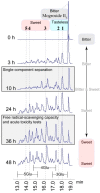Cucurbitane glycosides derived from mogroside IIE: structure-taste relationships, antioxidant activity, and acute toxicity
- PMID: 25140446
- PMCID: PMC6271920
- DOI: 10.3390/molecules190812676
Cucurbitane glycosides derived from mogroside IIE: structure-taste relationships, antioxidant activity, and acute toxicity
Abstract
Mogroside IIE is a bitter triterpenoid saponin which is the main component of unripe Luo Han Guo fruit and a precursor of the commercially available sweetener mogroside V. In this study, we developed an enzymatic glycosyl transfer method, by which bitter mogroside IIE could be converted into a sweet triterpenoid saponin mixture. The reactant concentration, temperature, pH and buffer system were studied. New saponins with the α-glucose group were isolated from the resulting mixtures, and the structures of three components of the extract were determined. The structure-taste relationships of these derivatives were also studied together with those of the natural mogrosides. The number and stereoconfiguration of glucose groups present in the mogroside molecules were found to be the main factor to determine the sweet or bitter taste of a compound. The antioxidant and food safety properties were initially evaluated by their radical scavenging ability and via 7 day mice survival tests, respectively. The results showed that the sweet triterpenoid saponin mixture has the same favorable physiological and safety characteristics as the natural mogrosides.
Conflict of interest statement
The authors declare no conflict of interest.
Figures





References
-
- Takemoto T., Arihara S., Nakajima T., Okuhira M. Studies on the constituents of Fructus momordicae. I. On the sweet principle. J. Pharm. Soc. Jpn. 1983;103:1151–1154. - PubMed
-
- Kasai R., Nie R.L., Nashi K., Ohtani K., Zhou J., Tao G.D., Tanaka O. Sweet cucurbitane glycosides from fruits of Siraitia siamensis (chi-zi luo-han-guo), a Chinese folk medicine. Agric. Biol. Chem. 1989;53:3347–3349. doi: 10.1271/bbb1961.53.3347. - DOI
-
- Matsumoto K., Kasai R., Ohtani K., Tanaka O. Minor cucurbitane-glycosides from fruits of Siraitia grosvenori (Cucurbitaceae) Chem. Pharm. Bull. 1990;38:2030–2032. doi: 10.1248/cpb.38.2030. - DOI
Publication types
MeSH terms
Substances
LinkOut - more resources
Full Text Sources
Other Literature Sources

